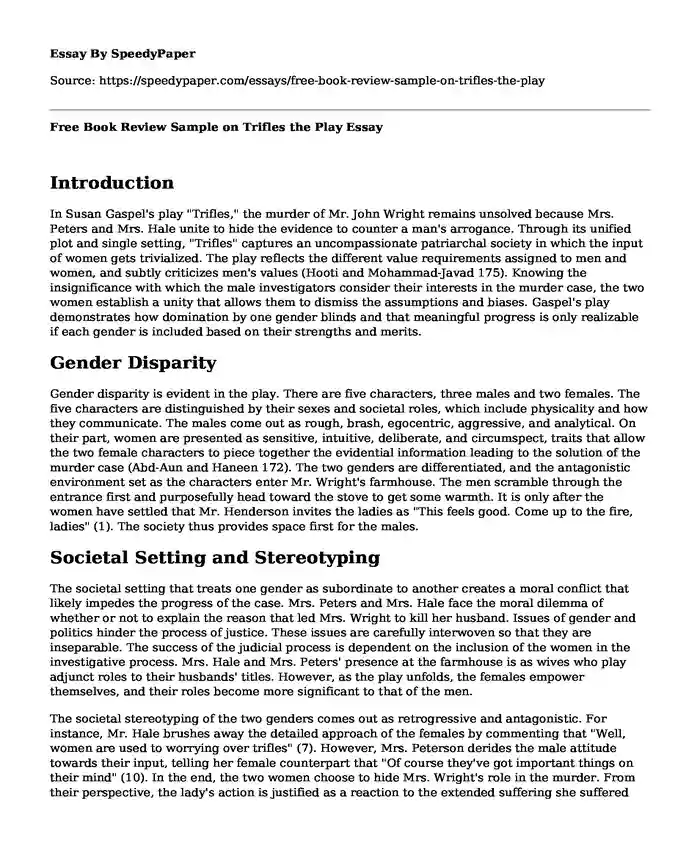
| Essay type: | Book review |
| Categories: | Stereotypes American literature Gender in literature |
| Pages: | 3 |
| Wordcount: | 657 words |
Introduction
In Susan Gaspel's play "Trifles," the murder of Mr. John Wright remains unsolved because Mrs. Peters and Mrs. Hale unite to hide the evidence to counter a man's arrogance. Through its unified plot and single setting, "Trifles" captures an uncompassionate patriarchal society in which the input of women gets trivialized. The play reflects the different value requirements assigned to men and women, and subtly criticizes men's values (Hooti and Mohammad-Javad 175). Knowing the insignificance with which the male investigators consider their interests in the murder case, the two women establish a unity that allows them to dismiss the assumptions and biases. Gaspel's play demonstrates how domination by one gender blinds and that meaningful progress is only realizable if each gender is included based on their strengths and merits.
Gender Disparity
Gender disparity is evident in the play. There are five characters, three males and two females. The five characters are distinguished by their sexes and societal roles, which include physicality and how they communicate. The males come out as rough, brash, egocentric, aggressive, and analytical. On their part, women are presented as sensitive, intuitive, deliberate, and circumspect, traits that allow the two female characters to piece together the evidential information leading to the solution of the murder case (Abd-Aun and Haneen 172). The two genders are differentiated, and the antagonistic environment set as the characters enter Mr. Wright's farmhouse. The men scramble through the entrance first and purposefully head toward the stove to get some warmth. It is only after the women have settled that Mr. Henderson invites the ladies as "This feels good. Come up to the fire, ladies" (1). The society thus provides space first for the males.
Societal Setting and Stereotyping
The societal setting that treats one gender as subordinate to another creates a moral conflict that likely impedes the progress of the case. Mrs. Peters and Mrs. Hale face the moral dilemma of whether or not to explain the reason that led Mrs. Wright to kill her husband. Issues of gender and politics hinder the process of justice. These issues are carefully interwoven so that they are inseparable. The success of the judicial process is dependent on the inclusion of the women in the investigative process. Mrs. Hale and Mrs. Peters' presence at the farmhouse is as wives who play adjunct roles to their husbands' titles. However, as the play unfolds, the females empower themselves, and their roles become more significant to that of the men.
The societal stereotyping of the two genders comes out as retrogressive and antagonistic. For instance, Mr. Hale brushes away the detailed approach of the females by commenting that "Well, women are used to worrying over trifles" (7). However, Mrs. Peterson derides the male attitude towards their input, telling her female counterpart that "Of course they've got important things on their mind" (10). In the end, the two women choose to hide Mrs. Wright's role in the murder. From their perspective, the lady's action is justified as a reaction to the extended suffering she suffered from her patronizing husband.
Conclusion
In conclusion, Gaspel succeeds at creating a storyline that captures how the domination of one gender makes it hard to acknowledge the strengths of another, and how conflicts that can be fatal or act as impediments to progress. The males are advantaged, have the first access to warmth and comfort, but remain indifferent to the complexity caused by their suppression, which necessitates the death of one of them.
Works Cited
Abd-Aun, Raad Kareem, and Haneen Ali Haleem. "The Woman as" the Other" in Glaspell's Trifles, Hansberry's A Raisin in the Sun and Kane's Blasted." International Journal of Arabic-English Studies 20.2 (2020): 169-186. https://doi.org/10.33806/ijaes2000.20.2.9Glaspell, Susan. Trifles: A play in one act. Baker's Plays, 2010.
Hooti, Noorbakhsh, and Mohammad-Javad Haj'jari. "The Iterability of the Woman Condition: a Derridean Reading of Glaspell's Trifles." Rupkatha Journal on Interdisciplinary Studies in Humanities 8.3 (2016): 173-182. doi: http://dx.doi.org/10.21659/rupkatha.v8n3.18
Cite this page
Free Book Review Sample on Trifles the Play. (2023, Oct 28). Retrieved from https://speedypaper.com/essays/free-book-review-sample-on-trifles-the-play
Request Removal
If you are the original author of this essay and no longer wish to have it published on the SpeedyPaper website, please click below to request its removal:
- Free Essay on the Training for Sales Representatives
- The Diamond Necklace: Character Analysis Essay Example
- Reflection Paper Example on a Life Event in My Family Using the Systems Theory
- Literary Analysis Essay Sample of Kate Chopin's Story of an Hour
- Free Essay Comprising Analysis of Pride and Prejudice by Jane Austen
- Free Essay: Citizenship and Power in Apes and Essence
- Psychoanalytical Criticism of "Sonny's Blues" by James Baldwin: Essay Sample
Popular categories




